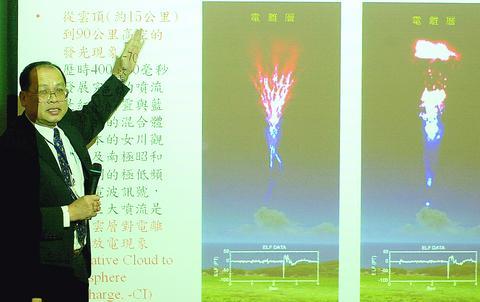Research by Taiwanese scientists on gigantic jets of lighting linking thunderclouds and the ionosphere was published yesterday in this week's edition of Nature magazine.
According to Lee Lou-chuang (李羅權), director of the council's National Space Program Office, the letter to Nature detailed the first conclusive observation data in the world indicating that a direct optical path was established from the thunderclouds about 15km above the Earth's surface to the ionosphere at the height of about 90km.

PHOTO: SEAN CHAO, TAIPEI TIMES
Lee, one of co-authors of the letter, stressed that the conventional picture of the global electric circuit needs to be modified to include the contributions of these gigantic jets and possibly sprites.
On July 22 last year, a team led by two physicists at National Cheng Kung University, Su Han-tzong (蘇漢宗) and Hsu Ruey-rong (許瑞榮), took high-resolution images of a rare "giant blue jet," which feeds energy from thunderstorms up into the ionosphere.
Researchers stationed on the southern tip of Taiwan and the university campus observed five giant blue jets, which extended from a thundercloud above the South China Sea near Luzon Island, The Philippines, to the electrically conducting ionosphere.
"A fully-developed gigantic jet optically spanned the thundercloud top at 15 km and the ionosphere at 90 km elevation," Lee said.
The upper bodies of the gigantic jets, which lasted for just 800 milliseconds, was similar to sprites, but their lower bodies resembled blue jets, Lee said.
Lee said that there was no evidence suggesting that the event was triggered by cloud-to-ground lightning. However, Lee said, extremely-low-frequency (ELF) radio waves associated with four of the five gigantic jets were detected by Japanese scientists working at stations in Antarctica and Japan.
In the last 10 years, scientists have discovered that the atmosphere above thunderclouds is not as tranquil as many people imagined.
Anecdotes told by pilots about transient luminous event have been captured by high-tech equipment since 1994. Those events have been classified into three categories: lighting-induced red sprites, upwardly discharging blue jets and gigantic jets.
The discovery of a "giant blue jet" by Victor Pasko of Pennsylvania State University in September 2001 was reported in a Nature cover story in April last year.
In 2001, a National Cheng Kung University team's images of red sprites were chosen as cover photo of Vol. 29 of Geophysical Research Letters,which was published in April last year.
"The potential of Taiwanese scientists deserved to be greatly encouraged," National Science Council Vice Chairman Hsieh Ching-chih (

Chinese Nationalist Party (KMT) Chairman Eric Chu (朱立倫), spokeswoman Yang Chih-yu (楊智伃) and Legislator Hsieh Lung-chieh (謝龍介) would be summoned by police for questioning for leading an illegal assembly on Thursday evening last week, Minister of the Interior Liu Shyh-fang (劉世芳) said today. The three KMT officials led an assembly outside the Taipei City Prosecutors’ Office, a restricted area where public assembly is not allowed, protesting the questioning of several KMT staff and searches of KMT headquarters and offices in a recall petition forgery case. Chu, Yang and Hsieh are all suspected of contravening the Assembly and Parade Act (集會遊行法) by holding

PRAISE: Japanese visitor Takashi Kubota said the Taiwanese temple architecture images showcased in the AI Art Gallery were the most impressive displays he saw Taiwan does not have an official pavilion at the World Expo in Osaka, Japan, because of its diplomatic predicament, but the government-backed Tech World pavilion is drawing interest with its unique recreations of works by Taiwanese artists. The pavilion features an artificial intelligence (AI)-based art gallery showcasing works of famous Taiwanese artists from the Japanese colonial period using innovative technologies. Among its main simulated displays are Eastern gouache paintings by Chen Chin (陳進), Lin Yu-shan (林玉山) and Kuo Hsueh-hu (郭雪湖), who were the three young Taiwanese painters selected for the East Asian Painting exhibition in 1927. Gouache is a water-based

Taiwan would welcome the return of Honduras as a diplomatic ally if its next president decides to make such a move, Minister of Foreign Affairs Lin Chia-lung (林佳龍) said yesterday. “Of course, we would welcome Honduras if they want to restore diplomatic ties with Taiwan after their elections,” Lin said at a meeting of the legislature’s Foreign Affairs and National Defense Committee, when asked to comment on statements made by two of the three Honduran presidential candidates during the presidential campaign in the Central American country. Taiwan is paying close attention to the region as a whole in the wake of a

OFF-TARGET: More than 30,000 participants were expected to take part in the Games next month, but only 6,550 foreign and 19,400 Taiwanese athletes have registered Taipei city councilors yesterday blasted the organizers of next month’s World Masters Games over sudden timetable and venue changes, which they said have caused thousands of participants to back out of the international sporting event, among other organizational issues. They also cited visa delays and political interference by China as reasons many foreign athletes are requesting refunds for the event, to be held from May 17 to 30. Jointly organized by the Taipei and New Taipei City governments, the games have been rocked by numerous controversies since preparations began in 2020. Taipei City Councilor Lin Yen-feng (林延鳳) said yesterday that new measures by